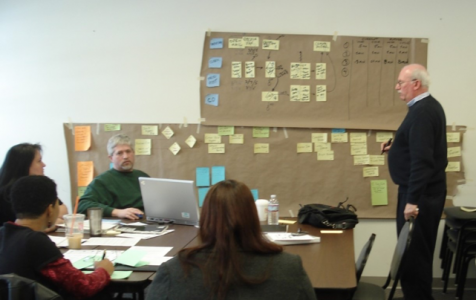Widgetized Section
Go to Admin » Appearance » Widgets » and move Gabfire Widget: Social into that MastheadOverlay zone
Lean: A Management Trifecta for the Public Sector
The views expressed are those of the author and do not necessarily reflect the views of ASPA as an organization.
By Kate McGovern
March 17, 2020

Consider the operational boost that would be generated by improving services, increasing employee morale and redeploying previously wasted capacity to the mission.
Lean process improvement principles and techniques have the same transformative potential for the public sector as in private industry. They are more than a set of tools that identify and eliminate waste and improve value. They’re a perspective, a way of thinking and a management system. Lean initiatives are taking place in dozens of states, counties and municipalities, though it would be naïve to suggest that implementation is easy.
Setting a Foundation
Lean management is counter-intuitive to bureaucratic micromanagement, so it’s critical to demonstrate proof of concept with a quantifiable success. A solid launch will energize early adopters and win over skeptics.
Pick an archaic process. The best go-to tool to tackle such a process is a structured improvement project, known as a kaizen. The majority of Lean initiatives begin with kaizens.
A kaizen team is comprised of the employees who do the work throughout the process. Guided by a Lean facilitator, they map the current workflow and redesign the process to improve quality and efficiency. Successful implementation produces dramatic results. One of the early kaizens in New Hampshire enabled the Employment Security Department to go from processing 6% of its appeals within 30 days to 86%. The agency went from 50th in the country to 16th in case aging.
Lift Off
As projects continue and work processes are steadily improved, those who participate as team members acquire a deeper understanding of kaizen. With a robust training and mentoring program, all staff learn to use a range of Lean tools, integrating their use throughout the workplace. Gradually, the newly acquired skills and techniques become habits. Practices that increase value and decrease inefficiency are baked in, without structured kaizen events.
The progression is not automatic, however. It happens in stages. Top leadership must remain engaged, providing unequivocal support for the effort. A state-wide or city-wide coordinator is needed to lead the initiative across the departmental silos. Each division should also have a point person to organize projects, demonstrate tools and spread Lean culture in the workplace. The coordinators work across silos to build a community of practice, further enhancing their skills and modeling a commitment to continuous improvement.
Failure to Launch
Lean initiatives are at greatest risk during the transition from the initial kaizens to a broad application of principles. After celebrating early efficiency gains, leaders tend to lose focus. They fail to realize that continuous improvement requires continuous commitment. Or, through attrition, leaders who initiated the Lean program are replaced by those with other priorities. Training is discontinued and coordinator positions remain unfilled. Lean skills and principles are not dispersed widely enough to take hold throughout the organization.
Dedicated Lean practitioners do their best to keep going, but they’re swimming upstream. With absent coordination for a comprehensive program, they are unable to tackle processes under the jurisdiction of departments where the effort has languished. The talents of these practitioners are underutilized, while deeply entrenched organizational inefficiencies remain in place. The transformation falls short of its potential.
Achieving a Culture of Continuous Improvement
With ongoing commitment, the trifecta of benefits can be realized. Better customer value. Increased capacity for mission. Improved employee morale.
As a commentary in Governing noted, “Most public-sector workers are amazing people who came to their careers in hopes of making a difference in the lives of the people in their counties, cities and states. We want to help the poor, protect the environment and keep our kids safe and healthy. Often what demotivates us are the same things that upset our customer—paperwork, red tape, long lines, endless bureaucracy…When we reduce these factors in order to improve a process… we remove the demotivation that seems to grind us down over time.”
Strategic Focus
While a truncated Lean program can still make efficiency gains, a series of disparate projects will not achieve cultural change. On the other hand, with persistent practice, Lean thinking can be internalized throughout the organization. It fuels organizational purpose, enabling the redeployment of previously wasted capacity to mission. In Vermont, for example, an Executive Order established the Program to Improve Vermont Outcomes Together (PIVOT) which linked improvement activities to strategic goals. In Rhode Island, pending legislation calls for tactical integration of the Lean initiative into state governance and operational systems.
Looking Ahead
In upcoming columns, we’ll explore more Lean lessons for public managers. The concept of continuous improvement is a natural fit. It’s a core value of those committed to public service.
Author: Kate McGovern, MPA, Ph.D. is a Lean trainer who conducts programs and facilitates kaizens for states, municipalities and nonprofits. In addition to her Lean work as a state employee and as a consultant for Daniel Penn Associates, Kate teaches at College Unbound. She is the author of A Public Sector Journey to Lean: Fighting Muda in Times of Muri. [email protected]


Robert Joyce
March 20, 2020 at 4:10 pm
Douglas McGregor and the New Public Administration organizational development idealists from the 1970’s would feel comfortable leaning in.